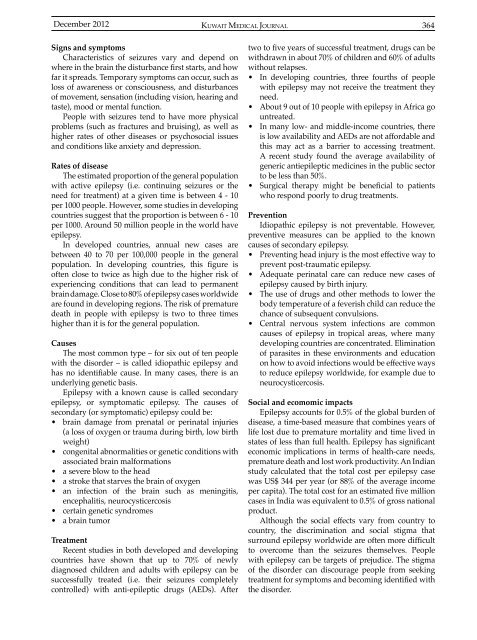Vol 44 # 4 December 2012 - Kma.org.kw
Vol 44 # 4 December 2012 - Kma.org.kw
Vol 44 # 4 December 2012 - Kma.org.kw
You also want an ePaper? Increase the reach of your titles
YUMPU automatically turns print PDFs into web optimized ePapers that Google loves.
<strong>December</strong> <strong>2012</strong><br />
KUWAIT MEDICAL JOURNAL 364<br />
Signs and symptoms<br />
Characteristics of seizures vary and depend on<br />
where in the brain the disturbance first starts, and how<br />
far it spreads. Temporary symptoms can occur, such as<br />
loss of awareness or consciousness, and disturbances<br />
of movement, sensation (including vision, hearing and<br />
taste), mood or mental function.<br />
People with seizures tend to have more physical<br />
problems (such as fractures and bruising), as well as<br />
higher rates of other diseases or psychosocial issues<br />
and conditions like anxiety and depression.<br />
Rates of disease<br />
The estimated proportion of the general population<br />
with active epilepsy (i.e. continuing seizures or the<br />
need for treatment) at a given time is between 4 - 10<br />
per 1000 people. However, some studies in developing<br />
countries suggest that the proportion is between 6 - 10<br />
per 1000. Around 50 million people in the world have<br />
epilepsy.<br />
In developed countries, annual new cases are<br />
between 40 to 70 per 100,000 people in the general<br />
population. In developing countries, this figure is<br />
often close to twice as high due to the higher risk of<br />
experiencing conditions that can lead to permanent<br />
brain damage. Close to 80% of epilepsy cases worldwide<br />
are found in developing regions. The risk of premature<br />
death in people with epilepsy is two to three times<br />
higher than it is for the general population.<br />
Causes<br />
The most common type – for six out of ten people<br />
with the disorder – is called idiopathic epilepsy and<br />
has no identifiable cause. In many cases, there is an<br />
underlying genetic basis.<br />
Epilepsy with a known cause is called secondary<br />
epilepsy, or symptomatic epilepsy. The causes of<br />
secondary (or symptomatic) epilepsy could be:<br />
• brain damage from prenatal or perinatal injuries<br />
(a loss of oxygen or trauma during birth, low birth<br />
weight)<br />
• congenital abnormalities or genetic conditions with<br />
associated brain malformations<br />
• a severe blow to the head<br />
• a stroke that starves the brain of oxygen<br />
• an infection of the brain such as meningitis,<br />
encephalitis, neurocysticercosis<br />
• certain genetic syndromes<br />
• a brain tumor<br />
Treatment<br />
Recent studies in both developed and developing<br />
countries have shown that up to 70% of newly<br />
diagnosed children and adults with epilepsy can be<br />
successfully treated (i.e. their seizures completely<br />
controlled) with anti-epileptic drugs (AEDs). After<br />
two to five years of successful treatment, drugs can be<br />
withdrawn in about 70% of children and 60% of adults<br />
without relapses.<br />
• In developing countries, three fourths of people<br />
with epilepsy may not receive the treatment they<br />
need.<br />
• About 9 out of 10 people with epilepsy in Africa go<br />
untreated.<br />
• In many low- and middle-income countries, there<br />
is low availability and AEDs are not affordable and<br />
this may act as a barrier to accessing treatment.<br />
A recent study found the average availability of<br />
generic antiepileptic medicines in the public sector<br />
to be less than 50%.<br />
• Surgical therapy might be beneficial to patients<br />
who respond poorly to drug treatments.<br />
Prevention<br />
Idiopathic epilepsy is not preventable. However,<br />
preventive measures can be applied to the known<br />
causes of secondary epilepsy.<br />
• Preventing head injury is the most effective way to<br />
prevent post-traumatic epilepsy.<br />
• Adequate perinatal care can reduce new cases of<br />
epilepsy caused by birth injury.<br />
• The use of drugs and other methods to lower the<br />
body temperature of a feverish child can reduce the<br />
chance of subsequent convulsions.<br />
• Central nervous system infections are common<br />
causes of epilepsy in tropical areas, where many<br />
developing countries are concentrated. Elimination<br />
of parasites in these environments and education<br />
on how to avoid infections would be effective ways<br />
to reduce epilepsy worldwide, for example due to<br />
neurocysticercosis.<br />
Social and ecomomic impacts<br />
Epilepsy accounts for 0.5% of the global burden of<br />
disease, a time-based measure that combines years of<br />
life lost due to premature mortality and time lived in<br />
states of less than full health. Epilepsy has significant<br />
economic implications in terms of health-care needs,<br />
premature death and lost work productivity. An Indian<br />
study calculated that the total cost per epilepsy case<br />
was US$ 3<strong>44</strong> per year (or 88% of the average income<br />
per capita). The total cost for an estimated five million<br />
cases in India was equivalent to 0.5% of gross national<br />
product.<br />
Although the social effects vary from country to<br />
country, the discrimination and social stigma that<br />
surround epilepsy worldwide are often more difficult<br />
to overcome than the seizures themselves. People<br />
with epilepsy can be targets of prejudice. The stigma<br />
of the disorder can discourage people from seeking<br />
treatment for symptoms and becoming identified with<br />
the disorder.
















